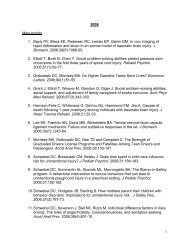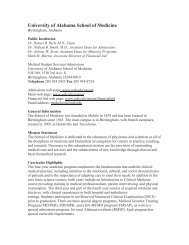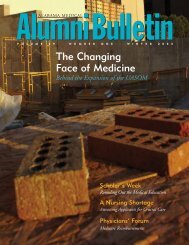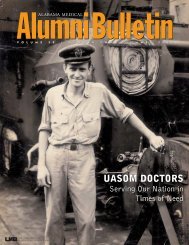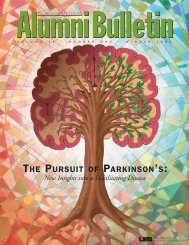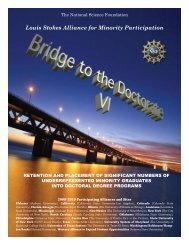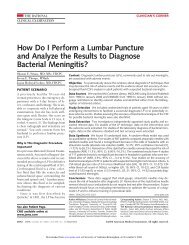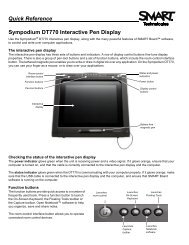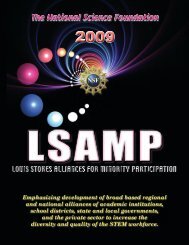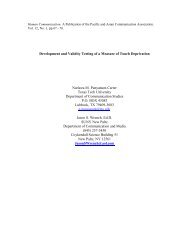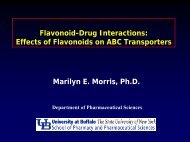AlumniBulletin - The University of Alabama at Birmingham
AlumniBulletin - The University of Alabama at Birmingham
AlumniBulletin - The University of Alabama at Birmingham
Create successful ePaper yourself
Turn your PDF publications into a flip-book with our unique Google optimized e-Paper software.
Coming Home<br />
NEUROLOGY CHAIR RETURNS TO UAB<br />
By Russ Willcutt<br />
His academic history suggests th<strong>at</strong> Ray L. W<strong>at</strong>ts, M.D.,<br />
is a man who’s interested in systems, whether they be<br />
the imprints <strong>of</strong> electrical circuit boards or the neurological<br />
networks <strong>of</strong> the human body. W<strong>at</strong>ts is a<br />
renowned neurologist whose research focuses on movement disorders<br />
such as Parkinson’s disease, but he also holds undergradu<strong>at</strong>e<br />
degrees in electrical and biomedical engineering. He will be putting<br />
this diverse array <strong>of</strong> expertise to use as the new chair <strong>of</strong> the<br />
Department <strong>of</strong> Neurology in the <strong>University</strong> <strong>of</strong> <strong>Alabama</strong> School <strong>of</strong><br />
Medicine <strong>at</strong> UAB.<br />
“Dr. W<strong>at</strong>ts is widely known for his skills as a clinician, a<br />
researcher, and an administr<strong>at</strong>or, and we’re delighted to welcome<br />
him to our medical school,” says William B. Deal, M.D., vice president<br />
and dean <strong>of</strong> the UASOM.<br />
Accepting the position is a homecoming <strong>of</strong> sorts for W<strong>at</strong>ts, who<br />
earned his bachelor <strong>of</strong> science degree, with honors, from the UAB<br />
School <strong>of</strong> Engineering in 1976. He then <strong>at</strong>tended medical school<br />
<strong>at</strong> Washington <strong>University</strong> in St. Louis, gradu<strong>at</strong>ing with highest<br />
honors in 1980. He spent the next four years <strong>at</strong> Massachusetts<br />
General Hospital, where he completed his first-year medical and<br />
neurology residencies. During both residencies, he was a clinical<br />
fellow <strong>at</strong> the Harvard Medical School. He also was an electromyography<br />
and motor-control fellow in the Clinical Neurophysiology<br />
Labor<strong>at</strong>ory from 1982 to 1983, a part-time resident member <strong>of</strong><br />
the Movement Disorders Clinic from 1982 to 1984, and chief<br />
neurology resident from 1983 until 1984. He spent the next two<br />
years as a medical staff fellow in the N<strong>at</strong>ional Institute <strong>of</strong> Mental<br />
Health Labor<strong>at</strong>ory <strong>of</strong> Neurophysiology <strong>at</strong> the N<strong>at</strong>ional Institutes<br />
<strong>of</strong> Health in Bethesda, Maryland.<br />
In 1986, W<strong>at</strong>ts joined the Emory School <strong>of</strong> Medicine as an assistant<br />
pr<strong>of</strong>essor in the Department <strong>of</strong> Neurology. He was also named<br />
director <strong>of</strong> the Movement Disorders Program and an <strong>at</strong>tending neurologist<br />
<strong>at</strong> Emory <strong>University</strong>-affili<strong>at</strong>ed hospitals, the Emory Clinic,<br />
and the Wesley Woods Geri<strong>at</strong>ric Hospital. He became an affili<strong>at</strong>e<br />
scientist with the university’s Division <strong>of</strong> Neurobiology in 1987, <strong>at</strong><br />
the same time accepting the position <strong>of</strong> medical director <strong>of</strong> the<br />
American Parkinson Disease Associ<strong>at</strong>ion’s (APDA) Inform<strong>at</strong>ion and<br />
Referral Center for the st<strong>at</strong>e <strong>of</strong> Georgia, which is loc<strong>at</strong>ed <strong>at</strong> Emory.<br />
He was then named co-director <strong>of</strong> the APDA’s Advanced Center for<br />
Parkinson’s Research in 1990.<br />
W<strong>at</strong>ts became an associ<strong>at</strong>e pr<strong>of</strong>essor in the Department <strong>of</strong><br />
Neurology <strong>at</strong> Emory in 1992 and was named full pr<strong>of</strong>essor in 1998.<br />
Th<strong>at</strong> same year he assumed the positions <strong>of</strong> vice-chairman for clinical<br />
affairs, chief <strong>of</strong> the neurology service <strong>at</strong> Emory <strong>University</strong><br />
Hospital, associ<strong>at</strong>e head <strong>of</strong> the Section <strong>of</strong> Neurology <strong>at</strong> <strong>The</strong> Emory<br />
Clinic, Inc., and chief <strong>of</strong> the neurology service <strong>at</strong> the Wesley Woods<br />
Geri<strong>at</strong>ric Center. In addition, W<strong>at</strong>ts was awarded the A. Worley<br />
Brown Chair in Neurology and was made director <strong>of</strong> the medical<br />
school’s Clinical Trials Office.<br />
Over the years, W<strong>at</strong>ts has conducted research into the neural basis<br />
<strong>of</strong> movement and postural disorders, including Parkinson’s and<br />
Alzheimer’s diseases. He is certified by the American Board <strong>of</strong><br />
With an eye toward innov<strong>at</strong>ive new tre<strong>at</strong>ments for neurological conditions,<br />
Ray L. W<strong>at</strong>ts, M.D., hopes to increase knowledge <strong>of</strong> how<br />
the human brain works.<br />
Psychi<strong>at</strong>ry and Neurology and a member <strong>of</strong> the American<br />
Neurological Associ<strong>at</strong>ion, the Society for Neuroscience, and the<br />
American Academy <strong>of</strong> Neurology, among others. He has been listed<br />
in Woodward/White’s Best Doctors in America since 1994, and in<br />
America’s Top Doctors, by Castle Connolly Medical, since 2000.<br />
“<strong>The</strong>se are very exciting times in neuroscience,” says W<strong>at</strong>ts.<br />
“We’re right on the brink <strong>of</strong> developing innov<strong>at</strong>ive new tre<strong>at</strong>ments<br />
for neurological conditions such as Parkinson’s disease, Alzheimer’s<br />
disease, stroke, and brain cancer, and I look forward to furthering<br />
our knowledge <strong>of</strong> how the brain works with my colleagues <strong>at</strong> UAB.”<br />
13



